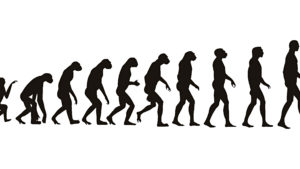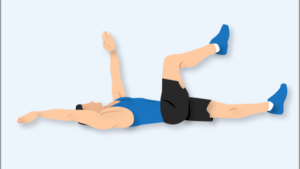
Once we were hunter-gatherers designed to cover miles every day, but many of us now lead sedentary lives. So what does this mean for the future of our health and fitness?
There is no doubt that we are at a pivotal crossroads for humanity. We evolved steadily over millions of years, but in the last 100, we’ve gone from horse and cart to skydiving from the edge of space. The industrial revolution and the digital age have removed the need for the movement and subsistence we used to rely on for survival. And it’s impacted on our fitness. With the rise of packaged food and the car, many of us go from work to sofa in a few steps. But as the Italian founder of Technogym, Nerio Alessandri, says, ‘Human beings were born to move. Man was designed to cover 20 miles a day. Nowadays we do less than a mile. And this sudden change generates severe side effects. Energy-wise there’s a huge disparity between what we take in and give out.’
Athletic tips and tricks for all
On the other side of the coin, elite athletes continue to push the boundaries of what’s possible. In a year when we have seen the world’s best perform at London 2012, how will exercise athletic evolve? Can humans keep in line with the Olympic motto of ‘faster, higher, stronger’ in their search for perfection? Leaps in the science of biomechanics, human physiology, design and digital technology mean improvements keep yielding better results – in the same vein as Team Sky and Team GB cycling to now legendary marginal gains, as masterminded by cycling coach Dave Brailsford.
But, in the 21st-century world, for every elite athlete that trains at altitude and recovers in a freezing cryotherapy chamber to push a few seconds faster, there are 10 obese people who are too heavy to walk to the door to pick up their pizza delivery. However, that’s all about to change. As Ricky Engleberg of Nike Digital says, ‘The same level of service and motivation we’ve provided to elite athletes will soon be available for everyone.’ Athletes already think nothing of being monitored on GPS units or changing their skin to go faster – there are swimsuits that mimic shark skin and athletics kit that move through the air and mimic the dimpled aerodynamics of a golf ball (shaving 0.023 seconds off a sprinter’s 100m time).
All this technology is now coming to the rest of us, whether that be through smart apps that help monitor our every move or calorie burned, relearning how to move our bodies in the most effective way, reopening the neural pathways we have forgotten and even interactive virtual gaming to help our fitness regimes.
The continuing rise of the gym
When it comes to the rest of mankind, it could be exercise that saves our lives. Dr Charles Clark, the consultant surgeon who wrote Health Revolution For Men (Piatkus, £12.99), says the future should be about using exercise as a medicine in place of much of the pharmaceutical industry. ‘There are two groups of people,’ he says. ‘Some who do no exercise and rely on drugs to make them better, and a growing number making the effort not to strain their cholesterol or weight at a young age by exercising.’
The evolution of fitness can be attributed to man’s need for survival. Men were nomads, hunters and endurance runners to catch prey – we all have the blueprint in our genetics to exercise. Man has evolved with very pointed specifications – an erect stance; large, powerful gluteal muscles; neck ligaments for stability; an Achilles and a foot arch; and sweat glands on hairless bodies to keep us cool when we move vigorously. Then, with the introduction of the plough and the industrial revolution, man exerted and moved himself less and less.
By the 20th century, fitness gained widespread attention in the US because of the alarming number of Americans who were found to be unfit during the drafting process. Cardiovascular fitness and diet became important, and in the 1950s American fitness expert Jack LaLanne, developed the first resistance cable pulley machine.
In the 1980s, Alessandri started building gym machines in his garage, which became the basis of Technogym. Later he patented the CPR (constant pulse rate) system – a scientific algorithm for pulse rate – and developed the first kinesis machines which promote natural movement and are found in most gyms today. ‘The evolution is now from standard exercises to personal tailor-made exercises for every individual,’ says Alessandri. ‘The market space is very different from the bodybuilders in th 1980s. It’s now for everyone – older people, women and the young.’ He points out that there has also been a huge evolution in biomechanics. ‘For example the chest press just used to be a simple linear movement,’ he says. ‘Now the chest press is complex – first of all it is convergent, then it goes down, as we have studied from a physiological standpoint how better to coordinate the muscles and fibres when they contract. We try to find the optimal exercise for every kind of athlete, using the least energy expenditure for the best performance.’ \
Exercise as medicine
So where does the future lie? Alessandri is famously secretive about his new projects, but concedes, ‘For any exercise, you need strength, resistance, flexibility and control. Now the big revolution is with control, through the neurological relation between movement and the brain’s input. The main problem in modern society is that the brain forgets how to move and coordinate the body. Now the most important evolution in the industry is that exercise can be a specific treatment for many pathologies, and has the potential to be even more powerful than traditional medicine – there is already clear research that, for Parkinson’s and Alzheimer’s, exercise can be better than chemistry. The combination of good diet combined with regular exercise is a powerful medicine and the pharmaceutical industry has kept this secret hidden because it is too easy.’
Alessandri’s comments are supported by the latest science. Recent research at the University of Arizona, USA, has found the brain has always been linked with exercise in a positive way. Scientist David Raichlen says, ‘Aerobic activity has played a role in the evolution of lots of different systems in the human body, which may explain why aerobic exercise seems to be so good for us. So we got interested in the brain as a way of looking at whether evolution generated exercise behaviours in humans through motivational pathways.’ They discovered that fit humans experience the infamous ‘runner’s high’ after exertion, which is caused by endocannabinoids in the brain. However, he is careful to add that, ‘Inactive people may not be fit enough to hit the exercise intensity that leads to this sort of rewarding sensation.’ However, the good news is they can train to get fit until they do.
Mind over matter
The working of the brain during exercise is also a huge area for elite athletes. Imagine being able to calm down a footballer before a penalty, or relax a golfer before a championship putt. Is it possible to train the brain out of emotion and increase mental focus so athletes can be cool under pressure? Neurotopia’s extraordinary performance Brain Training programme, in the US, can interpret brain functioning by placing a brainwave sensor headset on an athlete. The sensors interpret how the brain is functioning by listening to the brain’s electro-chemical activity. Neurotopia’s software converts this activity into graphs and scores to provide the athlete with visual feedback. As his brain state moves toward focus, the athlete can see the graph move upward and the score increase. Similarly, as he becomes distracted, the graph moves down and the score decreases. For training purposes, Neurotopia converts some of these graphs into video games whereby the game accelerates toward a goal when the brain’s activity is optimal, and slows down or stops when the brain shifts from this optimal state.
Alessandri believes the brain needs to go back to where we came from. He says, ‘We need to memorise the kinetic patterns once again. These days, kids don’t remember these patterns – in the old days they were climbing trees, now they sit in front of the TV and the PlayStation and memorise movement with their fingers. Alessandri doesn’t believe in interactive training to get fit – but it’s here to stay, and may be the best way to get kids and gamers off the couch. Sport giants Adidas recently linked its miCoach exercise gadget with the latest interactive gaming technology on PlayStation Move and Xbox Kinect. This means users can train alongside their sporting heroes on screen (such as Brazilian footballer Kaká and All Black Ma’a Nonu) with motion support and optical body tracking in the comfort of their living rooms. There are now more than 400 exercises, and PlayStation 3 users can even use a USB heart rate monitor.
Harnessing motivation
So is the evolution of modern fitness the search for perfection and the most natural movement of the human body? Or is it interactive virtual entertainment where training in your living room can be a whole fitness experience? ‘The feeling you get from playing an amazing basketball game, going to an invigorating workout class or being part of a huge 10K race are irreplaceable,’ says Engleberg. ‘Our hope is to make being active every day, or getting your workout in, feel more motivating.’
Motivation is certainly key, and Simon Drabble, director of miCoach at Adidas, agrees: ‘With camera and motion detectors, and more sensors on footwear and people, there is a big road map of future considerations.’ The Adidas Adizero football boot, now available to all, has a microchip that measures speed and distance on the pitch, while Nike has brought out a basketball shoe that measures how high you jump. Drabble adds that interactive technology helps more people get involved. ‘Some people struggle with how to go about exercising and don’t want to go to a gym. This new technology brings down the barriers to many of those not currently active. We can bring the interactive experience of professional coaching to everyone. It’s not replacing the gym or a run on the street, it’s just increasing the variation in training, and variation is motivational for exercise.’
All-weather training
It feels great to be able to go up a virtual alpine climb linked to your bike on a turbo trainer when you cannot get outside. And now there is a plethora of motivating apps to help you do everything from completing a Navy Seal fitness regime to finding the nearest shop where you can hydrate while you’re on a run.
Alessandri believes the future is the combination of natural movement and the latest technology. ‘This is the paradox,’ he says. ‘We need both the old approach and the new departure – the real change is about lifestyle. Nowadays it’s about prevention rather than cure – governments will not be able to afford the health bills otherwise. Soon being fit and healthy will become a social responsibility for all of us.’ But at least with the latest technology it should be more fun than ever before.
This move is a fantastic workout for your core strength, and requires no equipment so you can do it anywhere. It works the erector spinae, obliques, rectus abdominis […]


